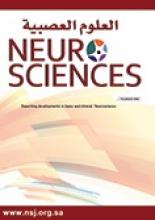Research ArticleOriginal Article
Open Access
Frontal theta/beta ratio changes during TOVA in Egyptian ADHD children
Islam F. Halawa, Basma B. El Sayed, Omnia R. Amin, Nagwa A. Meguid and Ann A. Abdel Kader
Neurosciences Journal October 2017, 22 (4) 287-291; DOI: https://doi.org/10.17712/nsj.2017.4.20170067
Islam F. Halawa
From the Department of Human Genetics (Halawa, Meguid), National Research Center, from the Unit of Clinical Neurophysiology (El Sayed, Kader), and from the Department of Psychiatry (Amin), Cairo University, Cairo, Egypt
MScBasma B. El Sayed
From the Department of Human Genetics (Halawa, Meguid), National Research Center, from the Unit of Clinical Neurophysiology (El Sayed, Kader), and from the Department of Psychiatry (Amin), Cairo University, Cairo, Egypt
MDOmnia R. Amin
From the Department of Human Genetics (Halawa, Meguid), National Research Center, from the Unit of Clinical Neurophysiology (El Sayed, Kader), and from the Department of Psychiatry (Amin), Cairo University, Cairo, Egypt
MDNagwa A. Meguid
From the Department of Human Genetics (Halawa, Meguid), National Research Center, from the Unit of Clinical Neurophysiology (El Sayed, Kader), and from the Department of Psychiatry (Amin), Cairo University, Cairo, Egypt
PhDAnn A. Abdel Kader
From the Department of Human Genetics (Halawa, Meguid), National Research Center, from the Unit of Clinical Neurophysiology (El Sayed, Kader), and from the Department of Psychiatry (Amin), Cairo University, Cairo, Egypt
MD
References
- ↵
- Jin W,
- Du Y,
- Zhong X,
- David C
- ↵
- Loo SK,
- Barkley RA
- ↵
- Coburn KL,
- Lauterbach EC,
- Boutros NN,
- Black KJ,
- Arciniegas DB,
- Coffey CE
- ↵
- Loo SK,
- Makeig S
- ↵
- Ogrim G,
- Kropotov J,
- Hestad K
- ↵
- Snyder SM,
- Hall JR
- ↵
- Loo SK,
- Hale ST,
- Hanada G,
- Macion J,
- Shrestha A,
- McGough JJ,
- et al.
- ↵
- Lansbergen MM,
- Arns M,
- van Dongen-Boomsma M,
- Spronk D,
- Buitelaar JK
- ↵
- Nijmeijer JS,
- Minderaa RB,
- Buitelaar JK,
- Mulligan A,
- Hartman CA,
- Hoekstra PJ
- ↵
- Voeller KK
- ↵
- Barry RJ,
- Clarke AR,
- Johnstone SJ,
- Brown CR
- ↵
- Hermens DF,
- Soei EXC,
- Clarke SD,
- Kohn MR,
- Gordon E,
- Williams LM
In this issue
Frontal theta/beta ratio changes during TOVA in Egyptian ADHD children
Islam F. Halawa, Basma B. El Sayed, Omnia R. Amin, Nagwa A. Meguid, Ann A. Abdel Kader
Neurosciences Journal Oct 2017, 22 (4) 287-291; DOI: 10.17712/nsj.2017.4.20170067
Jump to section
Related Articles
- No related articles found.





